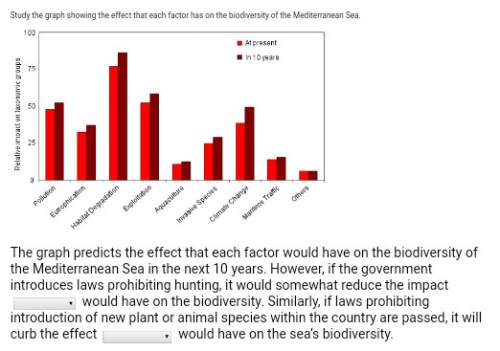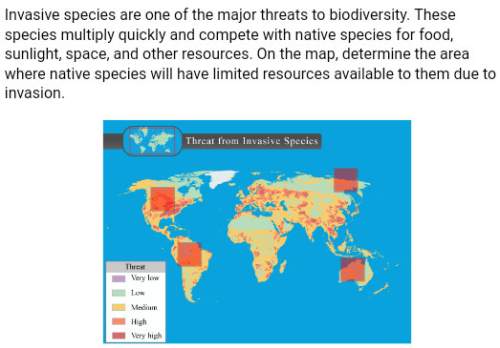
25 will mark as
conservationists establish that the carrying capacity of a population of deer in an extensive geographical area is 945. the current population of deer is 1,100. what is likely to happen to the population of deer?
a. the growth pattern will change from logistic to exponential.
b. the minimal viable population for the deer will increase.
c. deer from other populations will immigrate to find mates to reproduce successfully.
d. the population will remain healthy, and its numbers will increase.
e. the population size will drop until the numbers reach the carrying capacity.
what primarily determines the carrying capacity of a population?
a. birthrate
b. death rate
c. biotic and abiotic limitations
d. rate of migration
e. minimal viable population
these are options for the first question
1:
a) eutrophication
b) exploitation
c) pollution
2:
a) exploitation
b) climate change
c) invasive species





Answers: 3


Another question on Biology

Biology, 22.06.2019 08:00
In a vegetable garden 45 bean plants have been eaten by deer 5 are untouched what is the frequency of bean plants in the garden that have been eaten?
Answers: 3

Biology, 22.06.2019 16:30
You will create a molecular clock model for an arthropod gene. follow these guidelines to make your model: . your timeline will span from 90 million years ago to the present. the common ancestor in your model is an arthropod that lived 90 million years ago. the gene that you'll track codes for a protein in the species venom . the dna sequence youll track contains 10 nitrogen bases. you can choose the order of the bases and where the mutations occur. this gene mutates at a rate of approximately 0.76 base pairs every 17.1 million years. to build your model,/ calculate the estimated time period it takes for 1 base pair to mutate. the first time period will only show the common ancestor. at the beginning of the second time period, three lineages will diverge from the common ancestor, each with a different mutation in their gene sequences. the first and third descendant species will survive for the rest of the timeline. the second descendant species was extinct 50 million years ago. calculate how long it will take for one full base pair mutation to occur. explain your reasoning by constructing a mathematical equation
Answers: 2

Biology, 22.06.2019 19:30
Using the gas pedal analogy explain the impact on the cell cycle of one mutated tumor suppressor gene allele versus two mutated tumor suppressor alleles
Answers: 1

Biology, 23.06.2019 00:00
What is the correct name for the animal pictured on the right? puma cougar panther mountain lion catamount
Answers: 1
You know the right answer?
25 will mark as
conservationists establish that the carrying capacity of a population...
conservationists establish that the carrying capacity of a population...
Questions


Mathematics, 16.11.2020 18:50




Mathematics, 16.11.2020 18:50

Mathematics, 16.11.2020 18:50







Business, 16.11.2020 18:50

Mathematics, 16.11.2020 18:50

Mathematics, 16.11.2020 18:50

Mathematics, 16.11.2020 18:50



Mathematics, 16.11.2020 18:50



